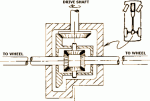Differentials confuse a lot of people. Although it appears from a diagram that there is a driven and a non driven side, it isn't really that way. Unless the differential is broken, neither axle shaft is directly connected to the ring and pinion set. The ring and pinion set drive a spider gear carrier, which drives the axle shafts.Okay, so I've heard quite a bit about the lockouts, and pulling an axle shaft. I'm not sure about how the lock outs help??? Do you run with them open or locked in? And I would assume with pulling the axle shaft you would pull the passenger side as that is the powered one, correct?
Differentials are designed so that the average of the rotation rate of the left wheel and the rotation rate of the right wheel is equal to the rotation rate of the propeller (drive) shaft divided by the gear ratio.
Yuck! Word problems!
Raverage = ( Rright + Rleft ) / 2
and that leads to:
Raverage = Rdriveshaft / Gearratio = ( Rright + Rleft ) / 2
If we assume, the propeller shaft is spinning at 100 RPM, and the gear ratio is 4-to-1,
the average rate the wheels spin (Raverage) is 100 RPM / 4 = 25RPM.
That leads to some interesting conditions. If the left wheel is stopped, and the right wheel is jacked, the right wheel will spin at 50 RPM, so that the average is:
( 50RPM + 0 ) / 2 = 25RPM.
And if the right wheel is stopped, and the left wheel is jacked, the left wheel will also spin at 50RPM, so the average is again:
( 0 + 50RPM ) / 2 = 25RPM,
And if we are going in a turn, and the right wheel is turning at 30 RPM, the left wheel will be spinning at 20 RPM, so the average is once again:
( 30RPM + 20RPM ) / 2 = 25RPM.
And another interesting condition happens if the drive shaft is stopped, and both wheels are jacked up, and you turn the right wheel at 25RPM forwards, the left wheel will turn at 25RPM backwards!
-Chuck
Attachments
-
13.5 KB Views: 17
Last edited:



